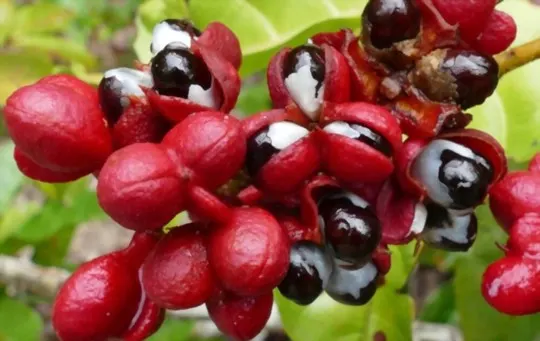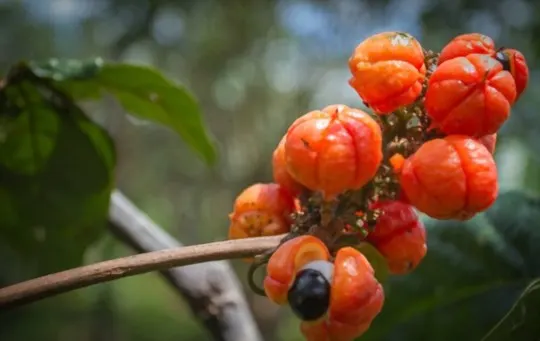Guarana – it’s a little known berry that has actually been around for centuries, yet most of us still find ourselves wondering just what exactly guarana tastes like.
Before we can properly answer this question, however, let’s get back to basics and explore the fascinating history and make-up of the elusive Brazilian seed!
From its roots to once-secretive uses by indigenous tribes to our newfound appreciation of its potential nutritional benefits, learning all about guarana is sure to leave you feeling well informed on one of nature’s hidden secrets.
So what does guarana taste like? Let’s dive in and find out!
What is Guarana?

Guarana is a tropical plant that is mostly found in the Amazon basin.
This plant produces small, bright-red berries that contain seeds which are rich in caffeine, tannins, and other substances.
The seeds of guarana are considered to be one of the richest sources of caffeine, making it an increasingly popular ingredient in energy drinks and supplements.
Guarana has been used for centuries by indigenous communities in South America as a natural stimulant and is known for its ability to enhance cognitive function, reduce fatigue, and increase energy levels.
Besides its stimulant properties, guarana is also believed to have other health benefits, including assisting with weight loss, boosting metabolism, and reducing inflammation.
With all its health benefits, it’s no wonder why guarana continues to be an important plant in modern herbal medicine.
What Does Guarana Taste Like?

Guarana is a caffeine-rich plant from the Amazon rainforest commonly found in energy drinks and supplements.
This plant has a slightly bitter taste, similar to that of coffee or dark chocolate but with a unique earthy undertone.
The flavor can be described as nutty, with a slightly sweet and tangy aftertaste.
Guarana can be consumed in various forms such as pills, powders or in energy drinks.
It can also be added to smoothies or cold brews for a caffeine boost.
Apart from being a stimulant, Guarana is also high in antioxidants, and it has been used by indigenous tribes for centuries to promote energy, focus, and overall well-being.
Pro-tip: If you’re not used to the caffeine in guarana, it’s best to start with a low dose to avoid negative effects such as jitteriness and insomnia.
Factors that Affect the Taste of Guarana

Guarana is a plant that is native to the Amazon basin and is known for its uniquely bitter taste and energizing properties.
However, several factors can affect the taste of guarana, including its growing conditions, processing method, and preparation technique.
Growing conditions: The taste of guarana can be influenced by its growing conditions.
The soil type, climate, and altitude can all affect the flavor profile of the plant.
Processing method: The processing method used to extract the guarana seeds’ caffeine and flavor can also affect its taste.
Ideally, guarana seeds should be roasted to bring out their nutty and bitter flavor.
Preparation technique: Guarana is often consumed in beverages or added to food as a flavoring agent.
The way it is prepared can significantly affect its taste.
Adding sugar or sweeteners can help mask its bitterness, and combining it with other ingredients can enhance its flavor.
Pro Tip: To enjoy guarana’s unique taste, try adding guarana powder to smoothies or using it as a flavoring agent in energy bars or baked goods.
Culinary Uses of Guarana

Guarana is a plant native to the Amazon basin, known for its high caffeine content and its culinary uses.
Guarana has a bitter taste and a slightly sweet aroma.
Some compare the flavor to that of coffee, but with a more astringent and earthy profile.
Guarana is commonly used in energy drinks, dietary supplements, and weight loss products due to its caffeine and antioxidant properties.
Additionally, guarana is a popular ingredient in Brazilian cuisine, used to flavor desserts, candies, and carbonated drinks.
It is also used as a natural preservative in food products.
In traditional medicine, guarana is used to treat fatigue, headaches, and low mood.
Its caffeine content is believed to boost cognitive function and improve alertness and memory.
Where to Buy Guarana and How to Use It?

Guarana is a fruit that is native to the Amazon region and is commonly used as a natural stimulant due to its high caffeine content.
Guarana has a bitter taste and is often mixed with other ingredients to make it more palatable.
Here’s where you can buy Guarana and how to use it:
You can buy Guarana in various forms such as powder, capsules or energy drinks from health food stores or online retailers.
To use Guarana powder, mix a small amount (usually half a teaspoon) with water, juice or smoothies.
You can also sprinkle it on top of cereal or yogurt.
Be cautious not to consume too much Guarana in one sitting, as it can cause jitteriness, anxiety, and other adverse effects.
Pro-tip: Guarana is often used as an ingredient in weight loss supplements and energy drinks due to its stimulating effects.
Make sure to consult a healthcare professional before taking Guarana supplements, especially if you have underlying health conditions or are taking medications.
Conclusion
Guarana is a plant native to the Amazon basin and is known for its energy-boosting properties.
It is commonly used in energy drinks and supplements due to its high caffeine content.
In conclusion, guarana is a natural source of caffeine that is becoming increasingly popular in the health and wellness industry.
While it does have a slightly bitter taste, it is a great alternative to traditional sources of caffeine and can be easily incorporated into your daily routine.

What Does Guarana Taste Like? A Comprehensive Guide
Ingredients
- Guarana
- Ingredients from your selected recipes
Instructions
- Select ingredients that work well together.
- Use a recipe or method that will enhance their natural taste.
- Taste and adjust the recipe as needed to achieve the desired flavor.

Carrie is a food writer and editor with more than 15 years of experience. She has worked for some of the biggest names in the food industry, including Bon Appétit, Food & Wine, and Martha Stewart Living.
As the Editor in Chief of IntroChicago.com, Carrie oversees all of the content on the site. She also manages the team of contributing writers and editors, who help to create delicious recipes, helpful tips, and informative articles that you’ll find on the site.
A native of the Chicago area, Carrie is passionate about all things food. She loves trying new restaurants and experimenting with new recipes in her kitchen. She’s also a graduate of the Culinary Institute of America, so she knows a thing or two about food!
